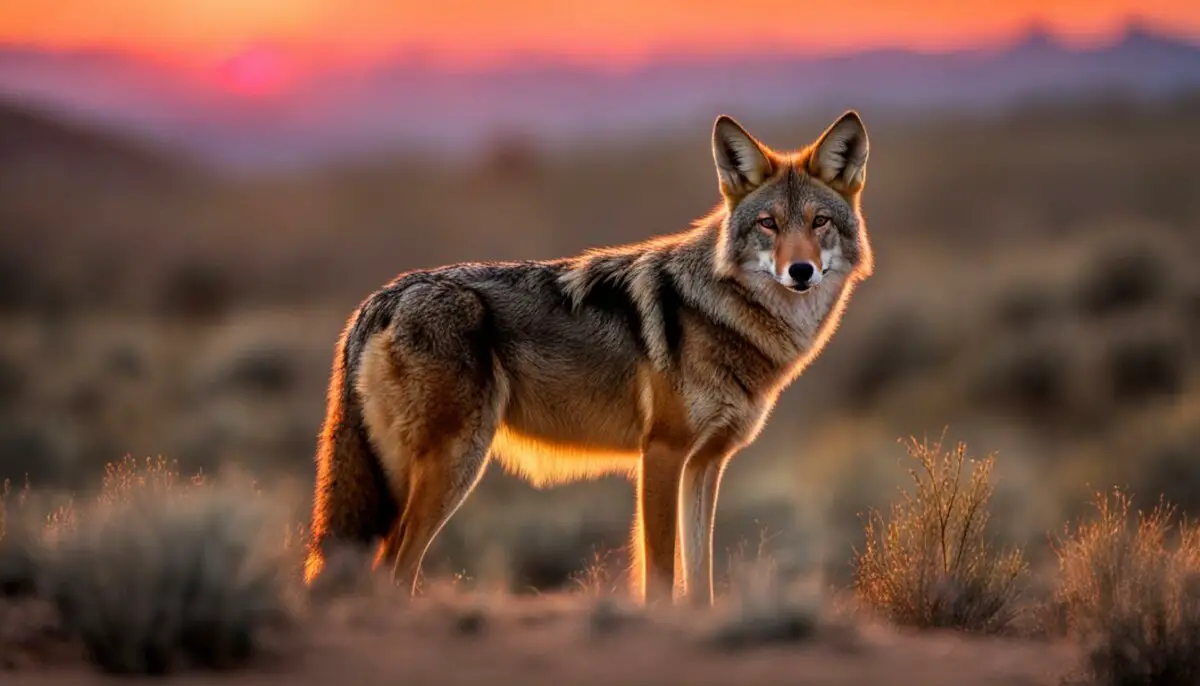Last Updated on 6 months by Francis
When it comes to the visual abilities of nocturnal animals like coyotes, there is much to learn. One of the intriguing questions that have piqued the curiosity of researchers and nature enthusiasts alike is whether coyotes can see infrared light. Understanding the visual perception of these predators can shed light on their hunting strategies and behavior, providing valuable insights into the world of animal vision.
In this article, we will explore the basics of coyote vision, the science behind infrared perception, and the implications for their behavior. We will also delve into the ongoing research on coyote vision and its potential for uncovering more mysteries of animal vision.
Contents
Key Takeaways:
- Coyotes are exceptional nocturnal hunters with specialized visual perception adapted for low-light conditions.
- While some animals have specialized infrared receptors, coyotes may have a limited ability to detect infrared light, providing them with an additional advantage in their hunting strategies.
- Factors such as environmental conditions can influence coyote vision, and further research will continue to uncover their mysteries of their visual perception and behavior.
The Basics of Coyote Vision
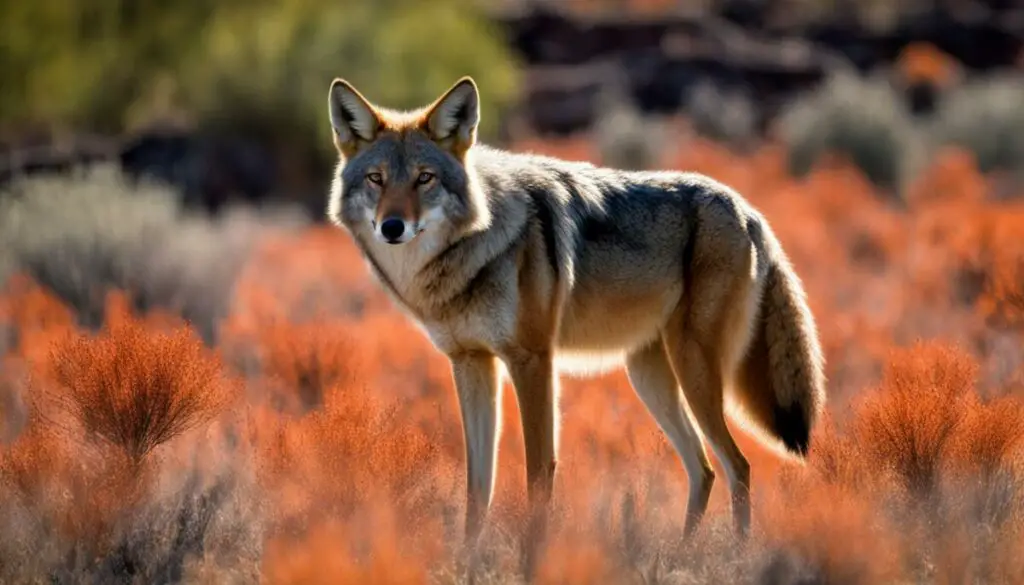
Before we explore whether coyotes can see infrared light, let’s first understand their visual capabilities. Coyotes are nocturnal animals, which means that they are active at night and are adapted to low-light conditions. In fact, their eyes are six times more sensitive to light than the human eye, allowing them to see in near-total darkness.
Unlike humans, coyotes have a greater number of rod cells in their eyes, which are responsible for detecting light. They also have a reflective layer called the tapetum lucidum located behind their retina that amplifies available light, making it easier for them to see in dimly lit environments.
While coyotes have excellent night vision, their daytime vision is not as acute as their nocturnal vision. This is because their eyes have fewer cone cells, which are responsible for detecting color and detail, and are better suited for daylight vision.
Coyotes have a wide binocular field of vision, meaning they can see objects from two different angles, giving them depth perception. This is particularly useful for hunting and navigating their territory.
Overall, coyotes have a highly specialized visual system that allows them to survive and thrive in their nocturnal environment.
“Coyotes have a highly specialized visual system that allows them to survive and thrive in their nocturnal environment.”
The Secrets of Night Vision

One of the most remarkable adaptations of coyotes is their night vision capabilities. Their eyes have evolved to take full advantage of the available light and enhance their ability to see in dimly lit environments. By optimizing their visual perception, they can navigate their territories, locate prey, and avoid predators more efficiently.
To achieve superior night vision, coyotes have several visual adaptations that work together to enhance their ability to see in the dark. Firstly, their eyes are relatively large, allowing them to gather more light. They also possess a high concentration of rod cells in their retina, which are more sensitive to light than cone cells and are responsible for visual perception in dim light conditions.
Another key feature of coyote eyes is the presence of a tapetum lucidum, a layer of tissue located behind the retina. When light enters the eye, it passes through the retina and strikes the tapetum lucidum, which reflects and amplifies the light back through the retina. This feature intensifies the available light, giving coyotes a significant advantage in low-light conditions.
Predator vision, such as that of coyotes, is essential for their survival, and their visual perception has evolved to reflect this. By mastering the art of night vision, coyotes can navigate their nocturnal world with greater ease and accuracy. Their superior visual perception is just one of the many fascinating adaptations that make them successful predators.
Exploring Infrared Light
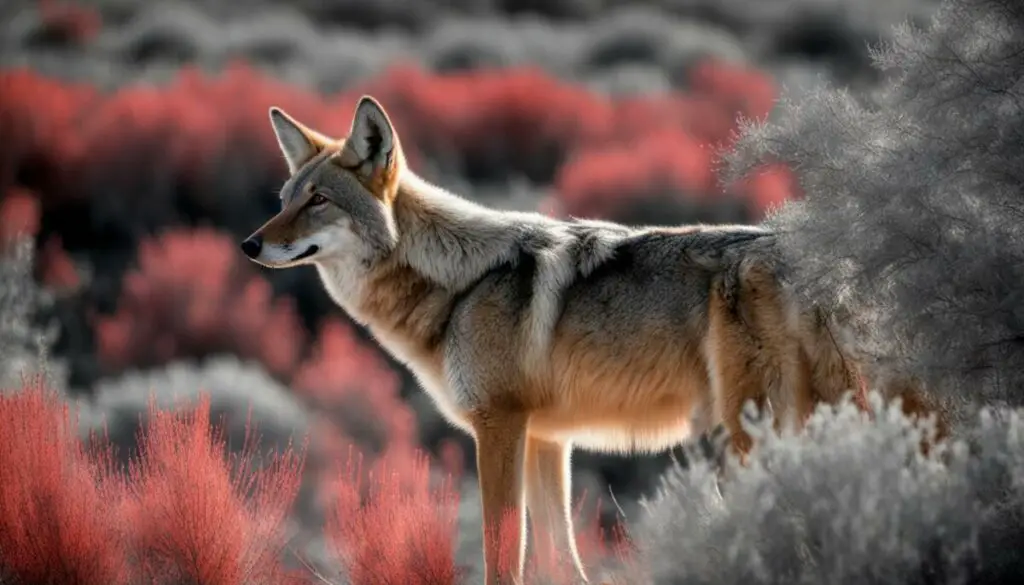
Infrared light is a fascinating phenomenon that is invisible to the human eye, but certain animals can detect it. The visual spectrum spans from 400 to 700 nanometers, while infrared light falls beyond 700 nanometers. This makes it longer in wavelength than visible light. The question remains whether coyotes possess the ability to see infrared light.
Coyotes have an exceptional sense of sight and rely heavily on it for their survival. Their eyes are located on the front of their face, providing them with binocular vision. This allows them to perceive depth and accurately judge distances, crucial for successful hunting. Moreover, their eyes’ shape and large pupils optimize their ability to gather and process ambient light, even in low-light conditions.
But can they see infrared light? While research on this topic is still developing, it is believed that coyotes may have limited infrared perception abilities. Their eyes possess a tapetum lucidum, which reflects light back through the retina, amplifying the available light. This adaptation could provide them with a slight advantage in detecting infrared wavelengths, although it is unlikely that they have specialized receptors like certain snakes or insects.
The Significance of Infrared Perception
Understanding whether coyotes can perceive infrared light can offer valuable insights into their visual perception and hunting strategies. Infrared light can help them detect warm bodies, such as potential prey or predators, even in complete darkness, supplementing their already keen night vision. Moreover, their sensitivity to infrared light can aid in navigation and territory marking.
“Infrared perception could provide [coyotes] with a slight advantage in detecting infrared wavelengths, although it is unlikely that they have specialized receptors like certain snakes or insects.”
However, it is essential to understand that the extent of their infrared perception abilities is still not fully understood. Factors such as the distance of the infrared sources, the strength of the infrared signals, and the presence of ambient light can all influence their infrared detection capabilities.
Exploring the science behind coyote vision and its ability to perceive infrared light sheds light on the fascinating adaptations of these nocturnal predators. Further research on this topic can help us gain a deeper appreciation for the complexities of their visual perception and the role it plays in their behavior.
The Science Behind Infrared Perception
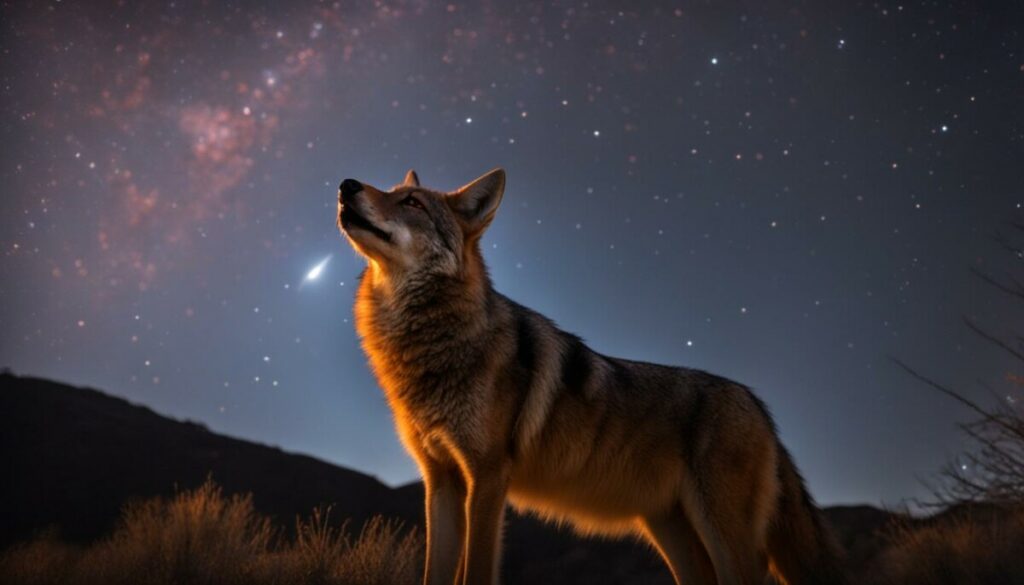
Some animals, such as snakes and certain insects, have specialized infrared receptors that allow them to detect and perceive infrared light. These receptors, known as pit organs or pit vipers, are highly sensitive to thermal radiation and play a crucial role in hunting and navigation.
However, unlike these animals, coyotes do not possess specialized infrared receptors. Instead, they rely on their visual perception to detect infrared light. This is because their eyes can detect a broader range of light waves than humans can see, including portions of the infrared spectrum.
Coyotes have two types of visual cells, rods and cones. Rods help them see in low-light conditions, while cones give them better color vision in brighter conditions. In addition, their eyes are designed to maximize the capture of available light, making them better adapted to hunting at night than humans.
While coyotes may not have the same level of infrared perception as animals with specialized infrared receptors, their visual perception is still highly adapted to their environment. By detecting a broader range of light waves, including portions of the infrared spectrum, they can better detect potential prey and other predators even in low-light conditions.
Infrared Light Detection in Predators
Predators that have specialized infrared receptors, such as pit vipers, use these receptors to hunt prey in complete darkness. They can detect the body heat of their prey, allowing them to strike with deadly precision even in pitch-black conditions.
While coyotes do not have specialized infrared receptors, they can still use infrared light to detect the body heat of potential prey. This ability is not as sophisticated as that of animals specifically adapted for infrared perception, but it may still give them an advantage in their hunting strategies.
Factors Affecting the Detection of Infrared Light
The ability to detect infrared light can be affected by various factors, including ambient light conditions, the distance of the infrared source, and the contrast between infrared and visible light. In addition, the sensitivity of an animal’s eyes to infrared light can vary based on its species and the time of day or night.
For coyotes, their ability to detect infrared light is likely influenced by their adaptation to nocturnal hunting. They are better adapted to low-light conditions than most other animals, which may enhance their ability to detect and use infrared light in their hunting strategies.
Studies and Findings on Coyote Vision

Several studies have explored the visual capabilities of coyotes, shedding light on their perception of the world around them. These studies have examined the anatomy and physiology of coyote eyes, as well as their behavior in response to different visual stimuli.
One study conducted by researchers at the University of Georgia analyzed the anatomy of coyote eyes and found that they possess a large pupil and a high number of rods, which are specialized photoreceptor cells that enable vision in low light conditions. The study’s authors suggest that these adaptations allow coyotes to see better in dimly lit environments and may play a role in their nocturnal hunting behavior.
| Research Study | Findings |
|---|---|
| University of Georgia Study | Coyotes have a large pupil and a high number of rods in their eyes, which may enhance their night vision and hunting abilities. |
| University of California, Berkeley Study | Coyotes are more sensitive to blue and green light than red light, which may reflect their preference for hunting small mammals that reflect these colors. |
| University of Calgary Study | Coyotes have a higher number of cones in their eyes than other nocturnal predators, which may indicate a greater color vision range than previously thought. |
Another study conducted by researchers at the University of California, Berkeley, found that coyotes are more sensitive to blue and green light than red light. This finding may reflect their preference for hunting small mammals that reflect these colors.
Furthermore, a study conducted by researchers at the University of Calgary found that coyotes have a higher number of cones in their eyes compared to other nocturnal predators. This may indicate a greater color vision range than previously thought.
The Implications for Nocturnal Animals
These studies have implications not only for coyotes but also for other nocturnal animals. By understanding the adaptations that enable animals to perceive their environment in low light conditions, researchers can gain insights into the behavior and survival strategies of nocturnal predators and prey.
Continued research in this area will undoubtedly uncover even more secrets of animal vision and nighttime perceptual abilities.
The Relationship Between Coyotes and Infrared Light

While coyotes do not possess specialized infrared receptors like some other animals, research suggests that they may have a limited ability to detect infrared light. This ability is not as sophisticated as that of animals specifically adapted for infrared perception, but it may still play a role in their hunting strategies and search for prey.
Infrared light detection is facilitated by specialized receptors in some animals, such as pit vipers and certain insects. These receptors are highly sensitive to thermal radiation and enable animals to detect prey or navigate their environment. While coyotes lack these specialized receptors, it is possible that they have adapted to detect infrared light using different mechanisms.
Research studies have shown that coyotes are capable of detecting infrared light to some extent. In one study, researchers analyzed the behavior of coyotes in response to infrared stimuli and found that they tended to avoid areas illuminated with infrared light. This suggests that they may be able to detect infrared light and perceive it as a potential threat or obstacle.
Factors such as distance, contrast, and ambient light may affect the ability of coyotes to detect infrared light. For instance, if the infrared source is too far or too close, it may not be detectable by the coyote’s visual system. Similarly, if the contrast between infrared and visible light is low, the coyote may not be able to distinguish between the two.
It is also important to note that while infrared light detection may play a role in their hunting strategies, it is likely just one of many visual cues that coyotes rely on in their nocturnal environment. Their acute senses of hearing, smell, and vision work in tandem to help them navigate and hunt in the dark.
Factors Affecting Coyote Vision
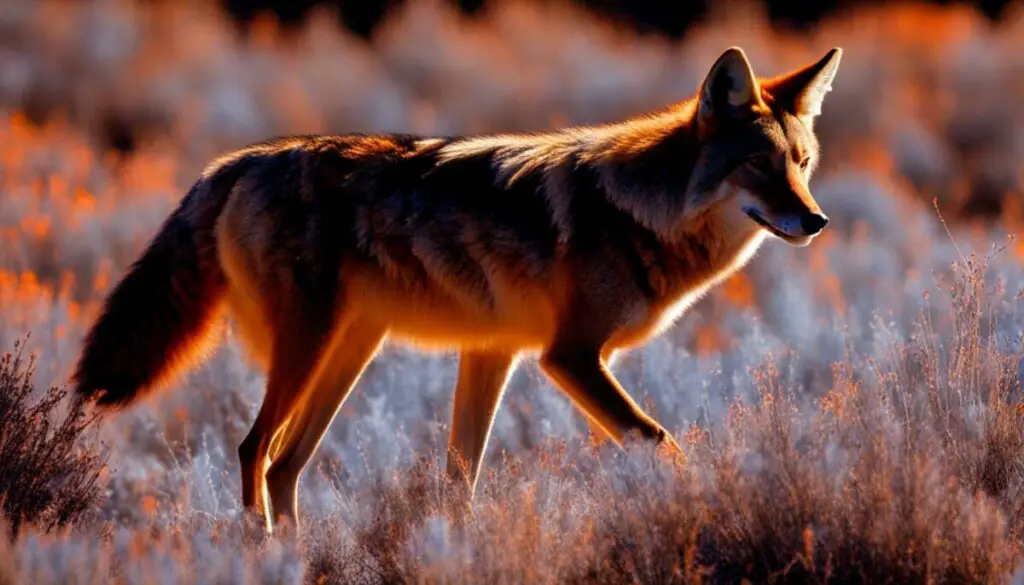
As nocturnal animals, coyotes have developed specialized visual adaptations to optimize their hunting and survival in low-light conditions. However, various environmental factors can influence their visual abilities.
One significant factor is the presence of ambient light. While coyotes have excellent night vision, a certain level of ambient light can improve their ability to see and process visual information. On the other hand, excessive light can have a negative effect, causing visual impairment and reducing their ability to detect subtle cues in their environment.
Another factor is the distance of infrared sources. While coyotes may have a limited ability to detect infrared light, this ability is most effective at close range. As the distance between the coyote and the infrared source increases, the intensity of the infrared light decreases, making it more difficult for coyotes to perceive.
The contrast between infrared and visible light is also a crucial factor. In environments with high levels of visible light, infrared light may be less distinguishable and have little impact on the coyote’s visual perception. However, in environments with low levels of visible light, infrared light may be more noticeable and provide additional visual cues for the coyote to utilize.
Understanding how these factors affect coyote vision can provide valuable insights into their behavior and hunting strategies. By adapting to their environment and utilizing available visual cues, coyotes can better navigate their territories, locate prey, and avoid predators.
Implications for Coyote Behavior
The visual perception of coyotes, including their limited ability to detect infrared light, can have significant implications for their behavior in their natural habitats. As nocturnal animals, coyotes rely heavily on their visual and other senses to survive.
One significant way that their visual perception affects their behavior is in their hunting strategies. Coyotes are skilled predators, utilizing their acute senses to locate and capture prey. While the extent to which they rely on their ability to detect infrared light is still not fully understood, it is likely that it plays a role in their hunting tactics in low-light conditions.
Additionally, their visual perception can assist them in identifying and avoiding predators in the darkness. Their exceptional night vision, combined with their ability to detect infrared light, can provide them with an advantage in detecting potential threats.
Their visual perception may also contribute to their ability to navigate their territories more effectively, allowing them to avoid obstacles and locate resources with greater ease.
Examples of Coyote Behavior
Observing coyote behavior in the wild can provide insight into how their visual perception affects their behavior. For example, studies have shown that coyotes will avoid crossing open spaces when visible light is present, but they will cross open spaces when only infrared light is present. This suggests that they may be utilizing their ability to detect infrared light to navigate and hunt more effectively.
Additionally, coyotes have been observed using their sense of smell in combination with their visual perception to locate prey. By tracking the scent of potential prey and using visual cues to zero in on their target, coyotes are able to successfully capture their prey even in low-light conditions.
Coyotes and Other Nocturnal Animals
While coyotes are exceptional nocturnal hunters, they are not the only animals that have adapted to survive in low-light conditions. Other nocturnal animals, including owls, bats, and raccoons, have also developed specialized adaptations to optimize their visual perception and other senses in the darkness.
Understanding the visual perception and behavior of these nocturnal animals can provide valuable insights into the complex and fascinating world of animal adaptation and survival.
Hunting Strategies and Infrared Light
Coyotes are master hunters, relying on their acute senses to track and capture prey. While they primarily use their sense of smell and hearing to locate prey, their visual perception also plays an essential role. Infrared light detection is an intriguing aspect of coyote vision that may offer them an additional advantage in their hunting strategies.
While researchers are still exploring the extent of coyotes’ ability to detect infrared light, it is clear that their eyes are optimized for low-light conditions, allowing them to navigate and hunt in the dark. Their tapetum lucidum, which reflects light back through their retina, further amplifies available light, making it easier for them to spot potential prey.
In addition to enhancing their ability to see in low-light conditions, the detection of infrared light may allow coyotes to detect prey that is camouflaged or hiding in foliage. Because infrared light can penetrate some materials, such as leaves and fur, it may make it easier for coyotes to locate prey that would be otherwise undetectable with their other senses.
| Hunting Strategies | Infrared Light Detection |
|---|---|
| Coyotes primarily use their sense of smell and hearing to track and locate prey. | The detection of infrared light may offer coyotes an additional advantage in their hunting strategies, allowing them to detect prey that is otherwise undetectable. |
| Their eyes are optimized for low-light conditions, making it easier for them to navigate and hunt in the dark. | The tapetum lucidum in their eyes further amplifies available light, enhancing their night vision. |
| Coyotes are opportunistic hunters, adapting their hunting strategies based on the prey available in their environment. | The detection of infrared light may assist them in locating potential prey and identifying predators in the darkness. |
While the detection of infrared light may offer coyotes an additional advantage in their hunting strategies, it is important to note that their reliance on this sense is likely limited. Unlike animals that have specialized infrared receptors, coyotes must rely on visual cues to detect infrared light. Additionally, environmental factors such as the presence of ambient light, the distance of infrared sources, and the contrast between infrared and visible light may all impact their ability to detect infrared radiation.
The Future of Coyote Vision Research
Coyotes have long been an enigma, inspiring awe and curiosity among humans. As our scientific knowledge expands, our understanding of these animals and their extraordinary visual capabilities grows. Ongoing research on coyote vision will continue to unlock the mysteries of their ability to perceive the world around them.
With new technologies emerging, such as advanced imaging techniques and genetic analyses, researchers will be able to delve even deeper into the intricacies of coyote vision. By examining the genetic underpinnings of their visual perception, we may gain insights into how their visual system has evolved and adapted to their environment over time.
The Value of Comparative Studies
Comparative studies with other nocturnal animals, such as owls and cats, may also provide valuable insights into coyote vision. By examining the differences and similarities in their visual systems, we can better understand how different animals have evolved to thrive in dimly lit environments.
Moreover, studies on coyote vision may have implications beyond the realm of animal behavior and ecology. Their visual perception may provide inspiration for the development of new technologies, such as sensors and imaging devices that can operate in low-light conditions.
Innovations in Research
New technologies such as CRISPR-Cas9 gene editing and optogenetics, which enable researchers to manipulate genes and neural activity in real time, offer exciting avenues of research for coyote vision. These techniques may allow researchers to pin down the exact genetic mechanisms underlying their vision, providing a more comprehensive understanding of how their visual system works.
Finally, citizen science projects may also play a role in advancing our understanding of coyote vision. These projects, which involve the general public in scientific research, can provide large amounts of data that would otherwise be difficult to collect. By engaging the public in coyote vision research, we can broaden our understanding of these fascinating animals and their exceptional visual capabilities.
In Conclusion
Coyotes have fascinated humans for centuries, and their unique visual system is no exception. Ongoing research on coyote vision promises to reveal even more insights into their behavior, evolution, and relationship with the world around them. By continuing to expand our knowledge of coyote vision, we can deepen our appreciation for the wonders of the natural world.
Conclusion
After exploring the question of can coyotes see infrared light, we have learned that while their ability to detect this type of light is not as sophisticated as certain other animals, they do possess a limited ability to perceive it. This insight sheds more light on their behavior and hunting strategies and highlights the adaptations that make them successful nocturnal predators.
Further research into coyote vision and the role of infrared light perception can offer a wealth of information for scientists and nature enthusiasts alike. By gaining a more comprehensive understanding of their visual perception, we can gain a deeper appreciation for their survival strategies, behavior, and adaptations.
As advancements in technology and scientific techniques continue, we can expect to learn even more about the mysteries of coyote vision and infrared light perception. This will enhance our overall understanding of these fascinating creatures and the world they inhabit.
So, can coyotes see infrared light? While the answer may not be a clear yes or no, we can conclude that these remarkable animals possess a unique visual perception that allows them to thrive in their nocturnal environment.
FAQ
Can coyotes see infrared light?
While coyotes may not possess specialized infrared receptors like some other animals, there is evidence to suggest that they have a limited ability to detect infrared light.
What is the tapetum lucidum?
The tapetum lucidum is a layer of tissue in the eyes of coyotes that reflects light back through their retina, enhancing their night vision.
Coyotes have exceptional night vision, which enables them to navigate and hunt in low-light environments.
Do coyotes rely on infrared light for hunting?
While the extent of their reliance on infrared light is not fully understood, it is likely that it provides them with an additional advantage in low-light conditions.
What factors affect coyote vision?
Various factors, such as the presence of ambient light, the distance of infrared sources, and the contrast between infrared and visible light, can influence the visual abilities of coyotes.
How does coyote vision contribute to their behavior?
Coyotes’ limited ability to detect infrared light can assist them in locating potential prey, identifying predators in the darkness, and navigating their territories more efficiently.
What research is being done on coyote vision?
Ongoing research on coyote vision aims to delve deeper into their ability to perceive infrared light and uncover additional secrets of their visual perception.

